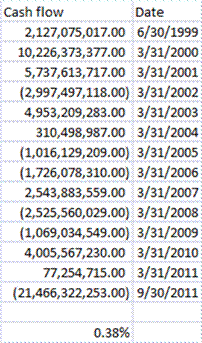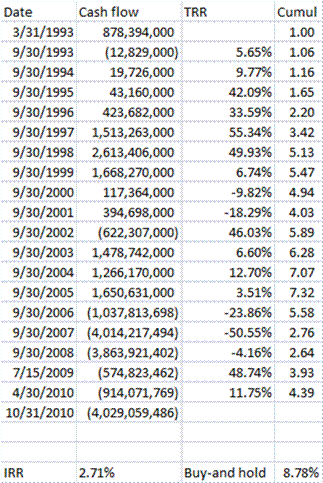I wrote the following for the 2012 Baltimore Business Review.? When it is publicly available on the web, I will highlight it.? For now, I will offer you the unedited version of my paper that will be published there:
-==-=-=-=-=-=-=-=–==-=–=-=-=-==–==-=–=-=-==-=-=-=-=-=-=-=-=-=-=-=-=-
Returns on Equity amid the Financial Crisis
Abstract
From 2005-2010, the change in public company returns on book equity [ROE] was wrenching during the financial crisis.? The results were uneven by sectors, and even by geography, for stocks traded in US equity markets.? This paper looks at the differences, and attempts to explain why there was so much variation by sector and geography.? After that, the paper attempts to explain the correlation between changes in ROE and stock returns, by year, sector, and geography.
Introduction
Since 2005, equity markets have seen a boom, a bust, and a tepid recovery. Financial stocks seem to have had the worst of it, but is that really true?
This paper attempts to disaggregate the differing effects of geography (countries/US states), and economic sector over time to try to understand how the boom, bust and recovery have affected public companies.
Part 1 ? Return on Equity
Method
This study excluded stocks with market capitalizations under $100 million at the end of the study period.? It also excluded miscellaneous financial companies such as exchange-traded products, closed-end funds, and special-purpose acquisition companies, because they don?t have operating businesses.? That left 3,796 companies that trade on US exchanges available for the analysis.
Given the tendency for businesses in states and countries to be concentrated in one or two sectors, a minimum was imposed for states and countries to be analyzed individually.? Countries with fewer than four companies trading on US exchanges were placed in the ?other? country category, and states with fewer than four companies trading on US exchanges were placed in the ?other? state category.
Over the years 2005-2010, data regarding book equity, net income, market capitalization, market price, share count, and total returns were gathered, and aggregated by geography (Country if non-US, state if US), sector, and year.
Using Ordinary Least Squares Regression, the following relationship was estimated:
Where:
- ?is the set of dummy variables for geography.
- ?is the set of dummy variables for sectors.
- ?is the set of dummy variables for the years 2005-2010.
- ?is the contribution to return on equity due to geography.
- ?is the contribution to return on equity due to sector.
- ?is the contribution to return on equity due to year.
- ?is the net income for a given geographic area, sector, and year.
- ?is the book equity for a given geographic area, sector, at the prior year end.
- ?is the error term for a given geographic area, sector, and year.
The reasons for using this sort of equation is twofold: first, by using dollar figures rather than earnings per share and book value per share, large companies are given their proper weight versus smaller companies.? Second, it allows for the effects of ROE changes by geography, sector and year to be separated.
In an analysis where there are multiple groups of dummy variables, at most one set of dummy variables can be complete if there is no intercept term, and no set can be complete if there is an intercept term.? If not, the regression will fail.? The choice of what to omit is arbitrary, and does not affect the relative relationships within a set of dummy variables.? For the purposes of this paper the sector dummy variables were left complete, and the coefficients on the first geographic area (Argentina) and the first year (2005) were set to zero.
Results
The R-squared of the regression was 55.7%, which has a prob-value of greater than 99.9%.
Here are the results of contribution to ROE by country:
|
18.1%
|
Mexico |
|
16.9%
|
Chile |
|
15.4%
|
Other Nations |
|
15.1%
|
Brazil |
|
14.1%
|
Australia |
|
13.4%
|
Spain |
|
13.2%
|
India |
|
10.6%
|
Bermuda |
|
10.6%
|
Hong Kong |
|
7.3%
|
Greece |
|
7.1%
|
Russia |
|
6.5%
|
Taiwan |
|
6.3%
|
Netherlands |
|
6.3%
|
Italy |
|
6.3%
|
Switzerland |
|
6.1%
|
China |
|
5.9%
|
Norway |
|
5.8%
|
Canada |
|
5.1%
|
Sweden |
|
5.1%
|
Germany |
|
4.1%
|
France |
|
3.7%
|
United Kingdom |
|
2.8%
|
United States |
|
1.9%
|
Singapore |
|
1.9%
|
Israel |
|
1.0%
|
Cayman Islands |
|
0.6%
|
Japan |
|
0.1%
|
South Korea |
|
0.0%
|
Argentina |
|
-0.2%
|
Puerto Rico |
|
-1.4%
|
Finland |
|
-3.1%
|
Ireland |
|
-3.2%
|
Luxembourg |
|
-6.3%
|
South Africa |
The United States is included for comparison purposes as the weighted average of the contribution to ROE by states.? There was not a separate variable for the US in the analysis.
As Latin America moved toward freer markets, with growing middle classes, their contributions to ROE were relatively high.? In general, resource rich nations tended to have higher contributions to ROE.
Mexico?s contribution to ROE was led by communication companies Telmex, America Movil, and Grupo Televisa and consumer-oriented companies like Coca-cola Femsa, FEMSA, and Wal-Mart de Mexico.? A growing middle class pushed up demand for these companies.
Chile?s contribution to ROE was led by the utilities Enersis and Empresa Nacional de Electricidad, the banks Banco Santander Chile and Banco de Chile, and chemical company Sociedad Quimica y Minera de Chile.? A growing economy boosted demand for electrical power, their banks didn?t make the mistakes made by most of the rest of the developed world, and Sociedad Quimica y Minera was in the ?sweet spot? for the chemicals it produced, particularly fertilizers, and lithium which goes into rechargeable batteries.
Brazil?s contribution to ROE was led by the energy giant Petrobras, the diversified mining company Vale, and the banks Banco Santander (Brasil), Itau Unibanco Holding, and Banco Bradesco.? Global demand for crude oil, iron ore, and other resources boosted the contributions to ROE with Petrobras and Vale.? Brazil?s banks also didn?t make the mistakes made by most of the rest of the developed world.
On the negative side, contributions to ROE in Finland were held down by Nokia, where they fell behind consumer trends with cell phones and other portable wireless devices.? Ireland was held back by banking sector, which lent too much on Irish residential property, amid other errors.? Luxembourg had ArcelorMittal, which slumped with the global steel industry as prices for coking coal and iron ore rose.? South Africa had the worst contribution to ROE as a country because of the heavy weight their economy has in basic materials.? Basic materials was a strong sector, but South Africa was concentrated in one the weakest ROE industries in that sector, gold mining.
Here are the results of contribution to ROE by US state:
|
18.6%
|
Washington |
|
16.9%
|
Arkansas |
|
13.0%
|
District of Columbia |
|
11.3%
|
Minnesota |
|
10.0%
|
Connecticut |
|
10.0%
|
Oregon |
|
8.9%
|
Rhode Island |
|
8.2%
|
New Jersey |
|
7.8%
|
Kentucky |
|
6.7%
|
Nebraska |
|
6.6%
|
Indiana |
|
6.2%
|
California |
|
6.1%
|
Georgia |
|
5.5%
|
Wisconsin |
|
5.4%
|
Missouri |
|
5.1%
|
Iowa |
|
5.0%
|
Texas |
|
4.4%
|
Tennessee |
|
3.2%
|
Illinois |
|
3.1%
|
Florida |
|
2.9%
|
Maryland |
|
2.8%
|
US Average |
|
2.5%
|
North Carolina |
|
1.2%
|
New York |
|
1.2%
|
Pennsylvania |
|
1.1%
|
South Carolina |
|
0.8%
|
Other |
|
0.6%
|
Ohio |
|
-0.4%
|
Utah |
|
-0.5%
|
Nevada |
|
-1.3%
|
Louisiana |
|
-2.3%
|
Arizona |
|
-3.6%
|
Colorado |
|
-4.6%
|
Massachusetts |
|
-5.6%
|
Alabama |
|
-7.9%
|
Oklahoma |
|
-10.3%
|
Virginia |
|
-31.9%
|
Kansas |
|
-83.6%
|
Michigan |
To some degree, historical accidents help explain why some states have high contributions to returns on equity, and others low contributions.? Washington State has Microsoft, Amazon, and Costco, all of which started out there.? Michigan has General Motors, Ford, and Chrysler; the automobile industry has long been a big part of the state economy.
The contribution to ROE of Arkansas can be entirely attributed to Wal-Mart.? Washington, DC can largely be attributed to Danaher, though Fannie Mae pulled the contribution to ROE down considerably as it failed in 2008.
The results of Kansas are dominated by Sprint Nextel, which has been a weak competitor in wireless telephony, though YRC Worldwide also had some impact on the low contribution to ROE as it was too acquisitive heading into a major recession.? Virginia has many strong companies, but Freddie Mac pulled the contribution to ROE down with it failure in 2008.
Companies don?t move often, so attributing the differing contributions to ROE to state policies is unlikely.? In the extreme cases listed above, all of the companies listed had been headquartered in their respective states for a long time, and most had been started there.
Here are the results of contribution to ROE by sector:
|
25.91%
|
Consumer Non-Cyclical |
|
23.31%
|
Basic Materials |
|
20.20%
|
Energy |
|
18.10%
|
Health Care |
|
14.59%
|
Utilities |
|
14.24%
|
Capital Goods |
|
14.07%
|
Technology |
|
10.56%
|
Services |
|
10.20%
|
Consumer Cyclical |
|
9.52%
|
Financial |
|
4.72%
|
Transportation |
|
-5.58%
|
Conglomerates |
The end of the first decade of the new millennium was characterized by strong development around the world, with many nations clamoring for resources and non-cyclical consumer goods, which why the contribution to ROE by sector was led by Consumer Non-Cyclicals, Basic Materials, and Energy.
Conglomerates are the smallest sector, at 0.3% of total book equity, so it is difficult to draw conclusions about why it had the lowest contribution to ROE.? That said, it is difficult to manage disparate enterprises for organic operating returns.? Increases in energy costs hurt transportation ROEs, which unlike utilities, have a harder time passing the price increases through.
Financial stocks saw their contribution to ROE drop because of the financial crisis.? The contribution to ROE includes two great years 2005-2006, two horrible years 2007-2008, and two years of recovery.? The contributions to ROE in the financial sector in 2007-2008 more than erased the gains made earlier in the decade.
Contribution to ROE for Consumer Cyclicals were damaged by bad results in the Automobile industry and slumping demand as the economy went into a recession in 2008, and had a rather weak recovery in 2009-2010.
Here are the results of contribution to ROE by year:
|
0.00%
|
2005
|
|
2.04%
|
2006
|
|
-1.28%
|
2007
|
|
-18.37%
|
2008
|
|
-8.06%
|
2009
|
|
-3.72%
|
2010
|
Contribution to return on equity rose 2% over 2005 levels in 2006.? In 2007, as the stock market reached new highs and began to fall in the fourth quarter of 2007, partially because the contribution to ROE fell below 2005 and 2006 levels.
In 2008, as the financial crisis arrived, the contribution to ROE plummeted.? Much of the effect was concentrated in financial stocks, but the contribution to ROE for the market as a whole fell 17%.? In 2009 and 2010, as the recovery from the crisis progressed contribution to ROE rose each year, but still remained below the contribution to ROE that existed during the boom years 2005-2007.
Part 2 ? Total Returns
Method
The same stocks as in the first section, and the same methods were used to estimate the following relationship, using Ordinary Least Squares:
Where:
- ?is the set of dummy variables for geography.
- ?is the set of dummy variables for sectors.
- ?is the set of dummy variables for the years 2005-2010.
- ?is the contribution to total return due to geography.
- ?is the contribution to total return due to sector.
- ?is the contribution to total return due to year.
- ?is the dollar value of gains or losses for a given geographic area, sector, and year.
- ?is the market capitalization for a given geographic area, sector, at the prior year end.
- ?is the error term for a given geographic area, sector, and year.
The dollar value of gains or losses is calculated by the change in market capitalization, plus dividends, less the proceeds of shares issued, plus the cost of shares bought back.
Results
The R-squared of the regression was 76.7%, which has a prob-value of greater than 99.9%.
Here are the results of contribution to total return by country:
|
216.77%
|
Israel |
|
24.53%
|
Chile |
|
17.34%
|
Singapore |
|
12.44%
|
Other Nations |
|
11.99%
|
China |
|
11.34%
|
Australia |
|
10.37%
|
Hong Kong |
|
8.32%
|
Mexico |
|
7.62%
|
Bermuda |
|
7.15%
|
Brazil |
|
4.14%
|
Netherlands |
|
3.41%
|
Germany |
|
3.24%
|
Greece |
|
2.32%
|
Spain |
|
1.93%
|
Norway |
|
1.72%
|
Italy |
|
1.62%
|
United Kingdom |
|
1.61%
|
Cayman Islands |
|
1.30%
|
US Average |
|
1.24%
|
Taiwan |
|
1.08%
|
India |
|
0.86%
|
France |
|
0.76%
|
Switzerland |
|
0.74%
|
Puerto Rico |
|
0.13%
|
Finland |
|
0.00%
|
Argentina |
|
-1.44%
|
Russia |
|
-3.46%
|
South Korea |
|
-4.16%
|
Canada |
|
-4.32%
|
Japan |
|
-4.44%
|
Ireland |
|
-6.19%
|
South Africa |
|
-8.72%
|
Sweden |
|
-17.49%
|
Luxembourg |
The United States is included for comparison purposes as the weighted average of the contribution to ROE by states.? There was not a separate variable for the US in the analysis.
Looking at the countries at the top and the bottom, Israel benefitted from Teva Pharmaceutical, Check Point Software Technologies, and a scad of little technology companies that soared in value.? Singapore was led by Avago Technologies which has been seeing strong growth in demand for their analog semiconductor devices.
Chile, as mentioned above, contribution to total return was led by the utilities Enersis and Empresa Nacional de Electricidad, the banks Banco Santander Chile and Banco de Chile, and chemical company Sociedad Quimica y Minera de Chile.? In addition, Lan Airlines grew their net income by 150% over the whole of the study period, as a growing middle class flew more often.
Ireland, Luxembourg and South Africa were low on the contribution to ROE by countries.? Ireland?s contribution to total returns was held back by its banking sector, as mentioned previously.? The same applies to Luxembourg with ArcelorMittal.? And again, South Africa had a low contribution to total returns as a country because of the heavy weight their economy has in basic materials.? Basic materials was a strong sector, but South Africa was concentrated in one the weakest industries for total returns in that sector, gold mining.
Sweden had three large companies Ericcson (Telecommunications Equipment), Volvo (Automobiles) and Swedbank (Banking) that underperformed.? Volvo and Swedbank were in weak industries given the financial crisis, while Ericcson underperformed versus competitors in its industry.
Note that the order of the lists of contribution to ROE and contribution to total return across are similar.? The correlation of the two sets of coefficients is 1.8% — statistically indistinguishable from zero, but the rank correlation of the two sets is 62.7%, which is significantly greater than zero with 95% certainty.? The high coefficient on Israel?s contribution to total returns throws the ordinary correlation coefficient off; without Israel, the correlation would be 64.5%.
Thus it seems that contribution to ROE and contribution to total return are related across countries.
Here are the results of contribution to total return by US state:
|
19.12%
|
Oregon |
|
15.18%
|
Kentucky |
|
13.85%
|
Iowa |
|
13.28%
|
Michigan |
|
12.77%
|
Nebraska |
|
12.53%
|
Arizona |
|
11.52%
|
Rhode Island |
|
9.35%
|
Colorado |
|
9.24%
|
Texas |
|
8.10%
|
Alabama |
|
7.18%
|
Louisiana |
|
7.02%
|
Oklahoma |
|
6.26%
|
Illinois |
|
5.58%
|
California |
|
5.01%
|
New Jersey |
|
4.58%
|
Massachusetts |
|
3.49%
|
Missouri |
|
2.62%
|
Maryland |
|
2.21%
|
South Carolina |
|
2.17%
|
Minnesota |
|
1.56%
|
Utah |
|
1.40%
|
Washington |
|
1.30%
|
US Average |
|
-0.02%
|
Wisconsin |
|
-0.49%
|
Connecticut |
|
-1.11%
|
New York |
|
-1.39%
|
Arkansas |
|
-2.02%
|
Indiana |
|
-3.13%
|
Pennsylvania |
|
-4.49%
|
Florida |
|
-5.21%
|
Ohio |
|
-7.04%
|
Tennessee |
|
-7.76%
|
North Carolina |
|
-8.19%
|
Kansas |
|
-8.42%
|
Nevada |
|
-12.06%
|
Georgia |
|
-19.45%
|
Other |
|
-21.02%
|
Virginia |
|
-33.73%
|
District of Columbia |
Oregon?s contribution to total return was high because of Nike and Precision Castparts.? Both have been based in Oregon since their founding.? The same can be said of Yum! Brands, Humana, and Brown Forman in Kentucky.? Yum Brands began with Pepsi?s purchase of Kentucky Fried Chicken, which was founded by Colonel Sanders out of home in Corbin, Kentucky in 1930.? Brown Forman was started in Kentucky in 1870 by George Garvin Brown.
Terra Nitrogen, LP was an Iowa firm from its founding until its parent company was acquired by CF industries in mid-2010.? It is counted as an Iowa firm for this study, but is now based in Illinois.
DC and Virginia have the lowest contributions to total returns because of Fannie Mae and Freddie Mac, respectively.? Georgia had a low contribution to total returns, largely due to SunTrust Banks, which holds the dubious distinction of receiving four installments of bailout cash.? Nevada had a low contribution to total returns because of their high exposure to the casino/gaming industry, which did poorly during and after the financial crisis.
All of these companies are historical accidents.? They were based in their states since their founding.
The state lists on contribution to ROE and contribution to total return across are not similar.? The correlation of the two sets of coefficients is -10.68% — statistically indistinguishable from zero.? The rank correlation of the two sets is 26.68%, which is also not significantly greater than zero with 95% certainty.
It seems there is no relationship at the state level between contribution to ROE and contribution to total return.
Here are the results of contribution to total return by Sector:
|
34.22%
|
Basic Materials |
|
33.86%
|
Consumer Non-Cyclical |
|
33.13%
|
Conglomerates |
|
30.87%
|
Transportation |
|
27.49%
|
Utilities |
|
24.38%
|
Technology |
|
23.69%
|
Consumer Cyclical |
|
22.88%
|
Services |
|
21.94%
|
Energy |
|
19.80%
|
Health Care |
|
19.51%
|
Capital Goods |
|
15.49%
|
Financial |
The lists between contribution to ROE and contribution to total return by sector are different.? The correlation coefficient between them is -0.50%, which is virtually zero.? But excluding the two smallest sectors, Conglomerates and Transportation, which have noisy data with only 2% of the total market capitalization, the correlation would be 71.51%, which would be statistically different from zero with 95% probability.? Thus it seems that contribution to ROE and contribution to total return are related across sectors.
The low contributors to total return by sector are led by Financials and Capital Goods, both of which did poorly in the recent crisis and the aftermath.? Basic Materials and Consumer Non-Cyclicals led the high contributors to total return by sector, as a growing global middle class created demand for commodities and staple consumer goods.
Here are the results of contribution to total return by year:
|
0.00%
|
2005
|
|
-5.35%
|
2006
|
|
-11.15%
|
2007
|
|
-67.18%
|
2008
|
|
5.51%
|
2009
|
|
-12.47%
|
2010
|
The contributions to ROE and contributions to total return by year are very similar, though the contribution to total return is far more volatile.? Also, total return anticipates changes in ROE, exacerbating the fall in 2007 and 2008, and anticipating tougher market conditions in 2011 in the results of 2010.
Without adjustment for leading effects, the correlation of the two series is 80.83%, which is different from zero with greater than 95% probability.? Thus it seems that contribution to ROE and contribution to total return are related across years.
In a regression of the two series, where ROE contribution by year is the independent variable, and total return contribution by year is the dependent variable, the beta of the regression was 2.86, with a 94% prob-value? for the coefficient and the regression as a whole.
That total returns should be levered 2.86 times to changes in ROE should surprise no one.? Markets anticipate, and change disproportionately, because they can?t tell whether changes are temporary or permanent, and so a multiple near 3 splits the difference.
Avenues for Further Study and Conclusion
The researcher did not use the CRSP database, because he had no easy access to it.? This study could be done over far more years and with greater precision.
The markets during 2005-2010 rewarded companies the served the growing global middle class, and aided the growth of the developing world.? It punished financial companies, and cyclical companies that did not have significant markets in the developing world.
In general, US state policies did not directly affect the financial results.? The best and worst companies by state were generally long term residents of the state in question.? Historical accidents dominate over companies that choose to move to other jurisdictions.
In general, contributions to ROE and total returns are related, but contributions to total returns lead contributions to ROE.? Markets anticipate changes in future profits.
Disclosure: David Merkel and clients of Aleph Investments own shares of Wal-Mart and Petrobras, as of the date this was originally written.












